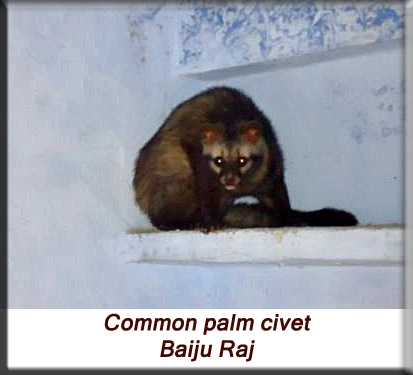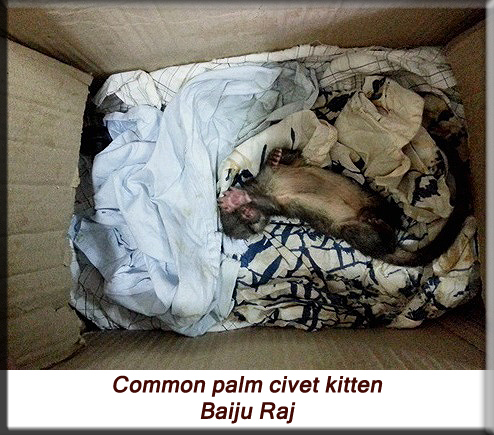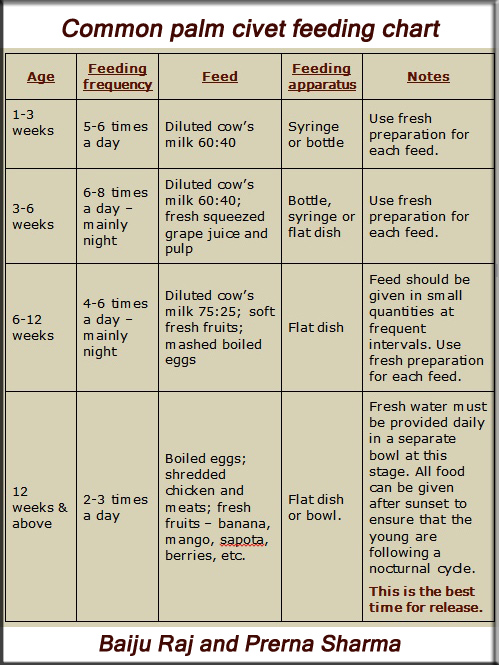Hand-rearing the Common palm civet, Paradoxurus hermaphroditus
Baiju Raj M. V. and Prerna Sharma

The Common Palm Civet Paradoxurus hermaphrodites
The common palm civet, also known as Asian palm civet or the Toddy cat is a small nocturnal mammal commonly found in South and South-East Asia. They are extremely fond of toddy and are hence named Toddy Cat. Primarily omnivorous in feeding habits, they feed on a variety of ripened fruits and also consume several invertebrates.
Little is known about the breeding behaviour of the common palm civet. They reproduce throughout the year and can give birth to up to 5 young while the average litter size observed is 2 kittens. Kittens have been rescued throughout the year irrespective of the seasons.
Commonly seen in not only in forest but also in cities and rural areas, the common palm civet readily breeds under roof tops, false ceilings and abandoned buildings. They are usually seen by the people while cleaning dark and unused spaces of old buildings. Most rescues are initiated once the mother abandons the kittens after being disturbed.
Do’s & Don’ts prior to rescue
1. Ensure that the kitten is truly orphaned or abandoned prior to rescue. A mother cat that has simply gone in search of food will return to the young ones. DO NOT mistakenly rescue kittens with mothers.
2. The kittens can be watched from a distance for a couple of hours to see if the mother returns. Refrain from crowding as the mother will not approach the kittens if there are too many people around the kittens. Once the mother returns, the kittens can be left where they are. She will herself shift them away once they are a little older.
3. Much like the domestic cat, the mothers have often been observed shifting their young ones to another safe place once they have been disturbed.
4. Rescued kittens must be hand-raised and rehabilitated in an appropriate manner and released at the age of 3-4 months.
Hand-rearing Common palm civet kittens

Rescued kittens are often found at a young stage before their eyes have even opened – they are extremely delicate and require a lot of care at this stage. The kitten’s eye’s open at approximately 10 days and such older kittens are easier to look after and most can even feed themselves.
Housing and caring for kittens
1. New born kittens with eyes closed: New-born kittens have delicate immune systems and require a lot of attention as they easily pick up infections. They can be housed in wooden or cardboard boxes and must be placed on a bedding of soft cotton cloth. The kittens must be placed on fresh, clean, dry cloth every time they soil the box. Even though the bedding will be changed frequently, the kittens must be placed back in the same box. Changing the box may make the kittens uncomfortable and insecure and require time for them to adjust to the new surroundings again – this must be avoided. The kittens also require external heat all day long at this vulnerable stage of their lives. Handling must be minimal to avoid the imprinting.
2. Older kittens with eyes open: Older kittens are comparatively easy to take care of. They may be housed in boxes until they are month old and shifted to enclosures thereafter. Again, refrain from changing the boxes or enclosures unnecessarily. Minimize handling to prevent negative imprinting on the animal which may have a negative impact on the animal’s survival after release.
Feeding Common palm civet kittens

“A rescue is completed when the animal is successfully released in its natural habitat”
Baiju Raj, M.V. Wildlife Biologist
Administrator – Agra Bear Rescue Facility
Member – Crocodile Specialist Group, IUCN
Special Officer – Wildlife Crime Control Bureau, Govt. of India
Soor Sarovar Bird Sanctuary, Agra, India – 282007
Mob.: +91-9917190666
Email: baiju@wildlifesos.org
Website: http://www.wildlifesos.org
Prerna Sharma, Wildlife Biologist
Mob.: +91-9756604080
Email: prernawildlife@gmail.com
Document edited by Devna Arora
Published in 2013, Rehabber’s Den
